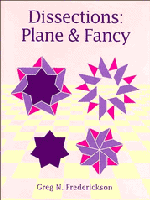Book contents
- Frontmatter
- Contents
- Preface
- 1 “Dat Pussle”
- 2 Our Geometric Universe
- 3 Fearful Symmetry
- 4 It's Hip to Be a Square
- 5 Triangles and Friends
- 6 All Polygons Created Equal
- 7 First Steps
- 8 Step Right Up!
- 9 Watch Your Step!
- 10 Just Tessellating
- 11 Plain Out-Stripped
- 12 Strips Teased
- 13 Tessellations Completed
- 14 Maltese Crosses
- 15 Curves Ahead
- 16 Stardom
- 17 Farewell, My Lindgren
- 18 The New Breed
- 19 When Polygons Aren't Regular
- 20 On to Solids
- 21 Cubes Rationalized
- 22 Prisms Reformed
- 23 Cheated, Bamboozled, and Hornswoggled
- 24 Solutions to All Our Problems
- Afterword
- Bibliography
- Index of Dissections
- General Index
3 - Fearful Symmetry
Published online by Cambridge University Press: 05 August 2012
- Frontmatter
- Contents
- Preface
- 1 “Dat Pussle”
- 2 Our Geometric Universe
- 3 Fearful Symmetry
- 4 It's Hip to Be a Square
- 5 Triangles and Friends
- 6 All Polygons Created Equal
- 7 First Steps
- 8 Step Right Up!
- 9 Watch Your Step!
- 10 Just Tessellating
- 11 Plain Out-Stripped
- 12 Strips Teased
- 13 Tessellations Completed
- 14 Maltese Crosses
- 15 Curves Ahead
- 16 Stardom
- 17 Farewell, My Lindgren
- 18 The New Breed
- 19 When Polygons Aren't Regular
- 20 On to Solids
- 21 Cubes Rationalized
- 22 Prisms Reformed
- 23 Cheated, Bamboozled, and Hornswoggled
- 24 Solutions to All Our Problems
- Afterword
- Bibliography
- Index of Dissections
- General Index
Summary
When the stars threw down their spears
And water'd heaven with their tears: Did he smile his work to see?
Did he who made the Lamb make thee?
Tyger, Tyger, burning bright,
In the forests of the night:
What Immortal hand or eye,
Dare frame thy fearful symmetry?
Dare we attempt to frame a fearful metaphor, using the last two stanzas of William Blake's “The Tyger,” from his Songs of Experience (1794)? Might the structure of polygons and stars be a sort of geometric meter, and the arrangement of cuts in the dissections be geometric rhyme? Do not our stars and other dissected figures luminesce in a cold mathematical stillness? Do not the best of the dissections fit together with a cunning that is diabolical? Dare we illustrate the preceding excerpt with a haloed rendition of Harry Lindgren's dissection of a {12/5} to a Latin Cross (Figure 3.1)?
As the rhyme in Blake's poem is not absolute, so also is the symmetry in lindgren's dissection not absolute. Lindgren's dissection comes close but does not possess reflection symmetry. Reflection symmetry is present when there exists a line of reference such that what is on one side of the line is exactly mirrored, or reflected, on the other side. As shown in Figure 3.2, if we split just one of the pieces into two pieces, then both the star and the cross will possess reflection symmetry about the dotted lines.
- Type
- Chapter
- Information
- DissectionsPlane and Fancy, pp. 20 - 27Publisher: Cambridge University PressPrint publication year: 1997



